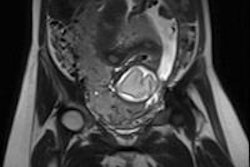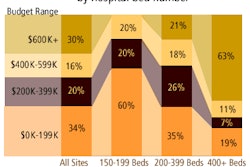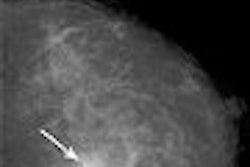Uterine artery embolization (UAE) with gelatin sponge particles can provide long-term relief from symptoms with few complications, according to Japanese researchers. They conducted this study because polyvinyl alcohol particles, which are used most commonly in UAE, are not commercially available in Japan, the group explained.
In addition, "gelatin sponge has become a familiar embolic agent for Japanese interventional radiologists, having been frequently used in embolotherapy for other diseases such as hepatocellular carcinoma," wrote Dr. Tetsuya Katsumori and colleagues from Saiseikai Shiga Hospital in Shiga, Japan (American Journal of Roentgenology Women's Imaging, March 2006, Vol. 186:3, pp. 848-854).
For this study, the researchers collected data from 96 women who had undergone UAE. The amount of time that had passed since the procedure ranged from three years to five years. All but one patient underwent bilateral UAE with 500-1,000 µm gelatin sponge particles for a technical success rate of 99%. MRI follow-up was done at one week, four months, and one year after UAE. The women were asked to answer a questionnaire on changes in symptoms such as menorrhagia and pain during menstruation.
According to post-UAE contrast-enhanced MR imaging, 89% of the largest fibroids were completely infarcted. The cumulative symptom control rates were 96.9% at one year, 94.5% at two years, and 89.5% at five years. The cumulative rates of overall failure were 4.2% at one year, 6.5% at two years, and 12.7% at years three through five.
"Our results suggest that UAE using gelatin sponge particles alone for symptomatic uterine fibroids provides long-term symptom control in most patients because the cumulative rates of symptom control were 89.5% at both three and five years," Katsumori's group wrote.
Future studies will have to look at such issues as fibroid regrowth and fertility. In this study, 13 women who attempted to get pregnant post-UAE were unable to do so, while two women who did not express a desire for pregnancy did become pregnant (both miscarried).
"We think that these results cannot provide definitive conclusions about how UAE using gelatin sponge particles alone can affect fertility," the authors wrote. "Further investigations are required."
With regard to fibroid regrowth, another group from Japan found that gelatin sponge particles did result in a higher fibroid infarct rate. These investigators from Osaka University will share the results Thursday at the 2006 Society for Interventional Radiology (SIR) meeting in Toronto. They compared MRI outcomes of UAE using superabsorbent polymer microspheres (SAP) to gelatin sponge particles (scientific session abstract 27).
For their study, they looked at 21 women in whom bilateral UAE was successful with either 500-900 µm SAP (group A) or 500 µm-1 mm gelatin sponge particles (group B). The patients underwent contrast-enhanced MRI before UAE and again three months and six months later. The investigators assessed the necrosis rate of the dominant fibroid at three months and the fibroid volume reduction rate at six months.
According to the results, the mean necrosis rate was 35% in group A and 88% in group B. Complete necrosis of the dominant fibroid was achieved in 18.2% of group A patients and 70% in group B. The mean volume reduction of the fibroid was 22.7% in group A versus 40.2% in group B.
Incomplete fibroid infarction, which was more common with SAP, may lead to regrowth and the recurrence of symptoms over the long term, they said.
By Shalmali Pal
AuntMinnie.com staff writer
March 29, 2006
Related Reading
Uterine fibroids associated with adverse obstetric outcomes, March 17, 2006
Post-UAE MRI demonstrates symptom control for adenomyosis, March 15, 2006
Advantages seen with artery embolization over myomectomy for uterine fibroids, February 2, 2006
Copyright © 2006 AuntMinnie.com



















